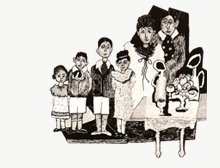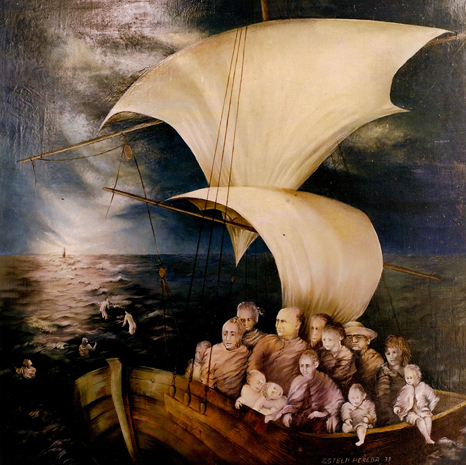Dimensión de lo Humano
The human dimension
PERSONAJES, SOMBREROS, RELATOS Y CREENCIAS
CHARACTERS, HATS, TALES AND BELIEFS
— años 1971 / 1975
— years between 1971 / 1975
A principios de los años 70 la mirada del mundo fue esperanzada, creíamos en el progreso de la historia pero resultaba indispensable modificar algunas cosas. Mi mirada se cargó de estos mismos pensamientos y simultáneamente de una actitud crítica e irónica en relación con la incapacidad de ciertos personajes para encontrar su lugar en el mundo y entender nuevas necesidades: sociales, ambientales, ecológicas, espirituales. Algunos estaban munidos de enormes sombreros que les impedían ver una realidad diferente de la propia. Otros eran sobrevolados por objetos geométricos amenazadores… Y también me gustó contar historias de gente sencilla con una vida más cerca de la tierra y con la capacidad de entender que lo que se ve no es todo lo que existe.
In the early 70s the outlook of the world was hopeful, we believed in the progress of history , but it was essential to alter some things. My mind filled with these same feelings and simultaneously with a critical and ironic attitude regarding the inability of certain characters to find their place in the world and understand new needs: social, environmental, ecological, spiritual. Some of them were armed with enormous hats that prevented them from seeing a reality different from their own. Others had threatening geometric objects hovering over them…and I also enjoyed telling stories about simple people whose lives are closer to earth and who have the capacity to understand that reality is not solely what meets the eye.
EP

Basilio Uribe,
Revista Criterio, N°1632.
Criterio review, N° 1632
— Buenos Aires, 25. 11. 1971.
Los temas de Estela Pereda están enraizados en lo indoamericano. Se dedican a una imaginería donde la gracia y la ternura se revisten de dejos populares sin descender de su nivel culto y exigente… Análogamente a lo que Berni hace con su Juanito Laguna o con Ramona Montiel, se trata aquí de la vida de Evaristo, paisano que llega a estanciero, se aburguesa, tiene preocupaciones de estatus y sirve de pretexto para comentar distintas situaciones de nuestra provincia harto conocidas por su autora.
Estela Pereda´s subjects are rooted in American Indian culture. They depict an imagery where grace and tenderness are wrapped in hints of folk culture without resigning their cultured and exacting level…drawing a parallel to what Berni does with his Juanito Laguna or with Ramona Montiel, this refers to Evaristo´s life , a peasant that turns into a ranch owner, becomes a bourgeois, is concerned about status and this serves as an excuse to comment on different situations in our province, extremely well- known by its author.


































